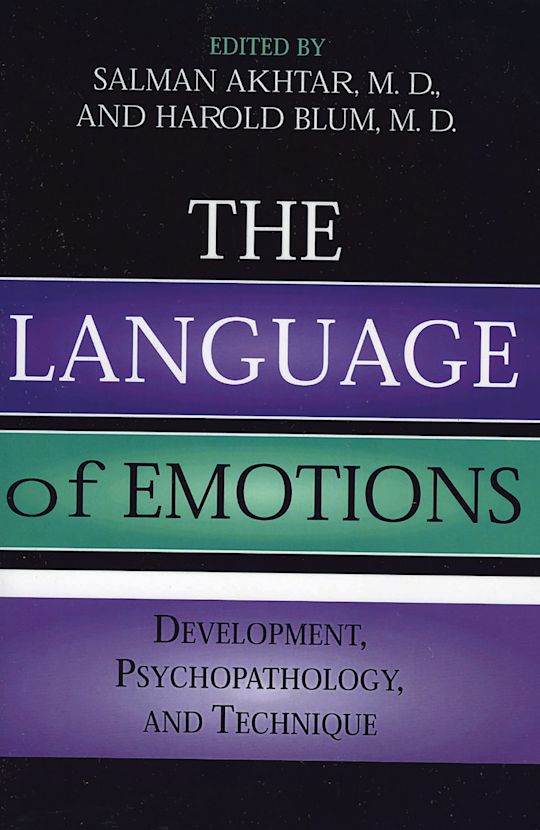- Home
- ACADEMIC
- Psychology
- Psychology - Other
- The Language of Emotions
The Language of Emotions
Developmental, Psychopathology, and Technique
Salman Akhtar (Anthology Editor) , Harold P. Blum (Anthology Editor) , Harold P. Blum (Contributor) , M. Hossein Etezady (Contributor) , Anni Bergman (Contributor) , Maria Fahey (Contributor) , M.A. (Contributor) , Keigo Okonogi (Contributor) , William M. Singletary (Contributor) , Phyllis Tyson (Contributor) , Daniel M. A. Freeman (Contributor) , Osamu Kitayama (Contributor) , Lilo Plaschkes (Contributor)
The Language of Emotions
Developmental, Psychopathology, and Technique
Salman Akhtar (Anthology Editor) , Harold P. Blum (Anthology Editor) , Harold P. Blum (Contributor) , M. Hossein Etezady (Contributor) , Anni Bergman (Contributor) , Maria Fahey (Contributor) , M.A. (Contributor) , Keigo Okonogi (Contributor) , William M. Singletary (Contributor) , Phyllis Tyson (Contributor) , Daniel M. A. Freeman (Contributor) , Osamu Kitayama (Contributor) , Lilo Plaschkes (Contributor)
This product is usually dispatched within 3 days
- Delivery and returns info
-
Free CA delivery on orders $40 or over
You must sign in to add this item to your wishlist. Please sign in or create an account
Description
This book is about affect-its origins, development and uses-and how it is viewed in a clinical setting. The authors track and further develop the recent major changes in the understanding of affect. From its roots in childhood development to its cross-cultural aspects, affect remains clinically relevant in issues such as aggression and forgiveness.
Table of Contents
Chapter 2 Affects in Development and Clinical Work-Discussion of Blum's Chapter "Language of Affect"
Chapter 3 Cross-Cultural Varieties in Experiencing Affect
Chapter 4 Joint Looking, Shared Experiencing, and Verbalizing Affects in the United States and Japan-Discussion of Kitayama's Chapter "Cross-Cultural Varieties in Experiencing Affect"
Chapter 5 Separation-Individuation, Object Constancy, and Affect Regulation
Chapter 6 The Internal Monster: An Aspect of Hostile Self and Object Constancy-Discussion of Tyson's Chapter "Separation-Individuation, Object Constancy, and Affect Regulation"
Chapter 7 Forgiveness: Origins, Development, Psychopathology, and Technical Relevance
Chapter 8 Acceptance, Mourning, and the Metabolism of Aggression-Two Discussions of Akhtar's Chapter "Forgiveness"
Chapter 9 Observations and Representations of the Earliest Relationship: A View from Separation-Individuation and Attachment
Chapter 10 The Intergenerational Legacy-Discussion of Bergman and Fahey's Chapter "Observations and Representations of the Earliest Relationship"
Chapter 11 Language and Affect-A Concluding Overview
Product details
| Published | Jan 04 2005 |
|---|---|
| Format | Paperback |
| Edition | 1st |
| Extent | 264 |
| ISBN | 9780765703286 |
| Imprint | Jason Aronson, Inc. |
| Dimensions | 229 x 151 mm |
| Series | Margaret S. Mahler |
| Publisher | Bloomsbury Publishing |
About the contributors
Reviews
-
This is a solid book. It should be read by any student of psychoanalysis who is ready and willing to speak a new language.
Journal of the American Psychoanalytic Association
-
The discussions are of high caliber and should provide an important contribution to the advancing understanding of emotion psychoanalytically.
Bulletin of the Menninger Clinic: A Journal for the Mental Health Professions
-
Enriched by cross-cultural perspectives and a Mahlerian Developmental slant, this new book uses substantial clinical examples and a wide array of concepts to explore the development of affect-affect and language, affect and pathology, affect and technique. Its distinguished contributors, including Akhtar, Bergman, Blum, Kitayama, and Tyson have indeed given clinicians a treat!
Fred Pine, Ph.D.
-
This book explores the many factors that contribute to the development of the capacity to put affects into words. These include the nature of the mother-infant dialogue, the impact of both culture and individual family psychopathology upon attachment, and the unfolding of the separation-individuation process. This book is a fascinating examination of the relationship between developmental forces, cultural values, family dynamics, and clinical practice. It will be of value to all clinicians who, with their patients, struggle to verbalize the non-verbal.
J. Alexis Burland, M.D., The Psychoanalytic Center of Philadelphia
-
This volume provides an excellent update of separation-individuation processes in light of contemporary theories of affect regulation, particularly in regard to the many channels available for affect communication between mother and child. Of special interest is the description of the influence of cross-cultural differences on character formation and on psychoanalytic technique.
Eleanor Galenson, M.D., Mt. Sinai School of Medicine


































